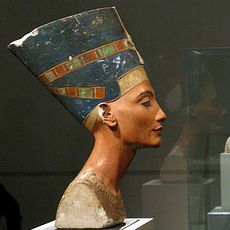Michelle Moran writes riveting novels about history from a woman's point of view. These novels are both extensively researched and richly imagined, leading to deeply atmospheric tales. The physical description is also a treat. While there is no question that Moran's heroines operate in a man's world, they more than measure up to those who would destroy them. And utter destruction is what threatens each of these women, powerful as they may be, whether in ancient Egypt or Napoleonic France.
Nefertiti is the tale of the great queen's rule, as told by her younger sister, Mutnodjmet. Nefertiti and her husband, Akhenaten, are incredibly ambitious, wishing to change Egypt's traditional religion and seat of power for their own greater glory. Disaster comes when the army is called on to build the new temples instead of guarding the restive borders, as well as the fact that Nefertiti produces only daughters to her rival's sons.
The Heretic Queen follows Nefertari, Nefertiti's niece. Despised by the Egyptian people for her iconoclastic heritage, she falls in love with and marries the man known to history as Ramses II, the Great. As his wife, Nefertari helps with the running of the kingdom while outwitting rivals and enemies. Even the Jewish slaves and their exodus get a mention in this lush tale.
Cleopatra's Daughter is the last of what is considered Moran's Egyptian series, beginning with the suicides of Cleopatra and Marc Antony. Selene and her twin, Alexander, are taken prisoner as the children of the unfortunate pair and shipped off to Rome as spoils of war. They are raised in the household of Caesar Augustus' sister and learn to navigate imperial politics while nursing the hope of one day returning to Egypt to rule. Ancient Rome seen through the eyes of a teenager makes this a good pick for the young adult set as well.
Moran jumps ahead nearly two thousand years to the era of the French Revolution in Madame Tussaud. Of course, the canny young Marie Grosholtz has no idea of her ultimate identity when this novel starts and she is commanded to be the tutor in sculpture to the king's sister. Moran manages quite the feat in making Marie's family sympathetic while they try to figure out who to ally themselves with during the Reign of Terror. Moran takes some liberties with historical fact just as the real Madame Tussaud did in her own memoir, but one hardly minds as they watch Marie persevere and triumph.
Moran's next foray into European history is during the Napoleonic Era with The Second Empress. While mostly seen through the eyes of Marie-Louise, a Germanic princess raised to rule and shanghaied into being the empress of the title, it is more of an ensemble piece than Moran's other books. Pauline is Napoleon's sister, who wishes to rule Egypt with her brother, for whom she has more than sisterly feelings. Hortense, Napoleon's stepdaughter, just wants to survive the bawdiness and machinations of the court. While these women keep the home fires burning in France, Napoleon is off to conquer Russia. Things don't end well for him, and at the end, Marie-Louise gets to go home to the life she loves.
The tragic story of the last Rani of Jhansi is fodder for the latest of Moran's historical novels. Leaving the West behind almost entirely, the tale of the "Rebel Queen" of India is ideally suited to Moran's descriptive skills. I learned a great deal about Indian traditions and mores from this book, which is wildly entertaining. Told from the view of one of her female bodyguards, the Durga Dal, Lakshmi exhausts diplomacy in trying to hold onto her kingdom after a series of tragedies. However, this is the second half of the book. In the first half, Sita comes from poverty to train as one of the Rani's bodyguards to avoid ending up as a temple prostitute. Much of the book is taken up with the politics of the Durga Dal, which Sita mistakenly perceives to be completely separate from that of the wider world. The ending is never really in doubt when the enemy is the British military juggernaut, but the joy is in the struggle.




Add a comment to: Women’s History Through Novels: Michelle Moran